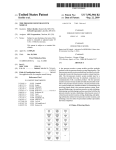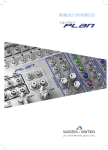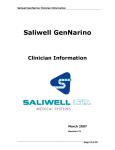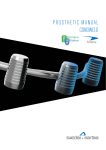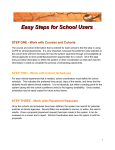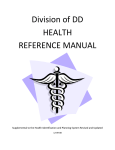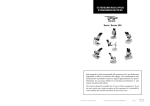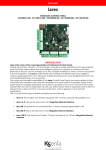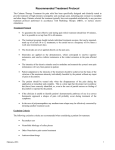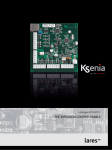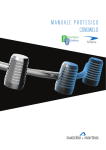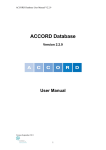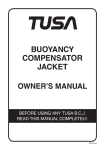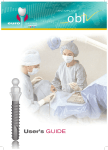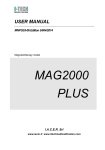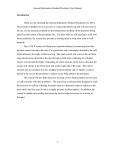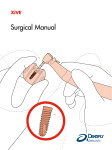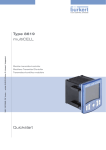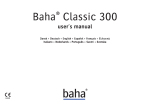Download b.o.p.t. prostheses - prosthetic manual - english
Transcript
PROSTHESES ON IMPLANTS W I T H B. O. P. T. T E C H N I QU E CONTENTS Introduction to the prosthesis on implants with B.O.P.T. technique 04 B.O.P.T. prosthesis for Outlink2 implants 8 B.O.P.T. prosthesis for Kohno and Shelta implants 10 Use protocols 14 Technical data sheets and indications 28 B.O.P.T. prosthesis for Global implants 12 Sweden & Martina develops and manufactures implant systems that offer both excellent clinical functionality and perfect aesthetic results. The prosthetic components available reflect the company’s updating and development capacity and cover all the requirements of prosthodontists and laboratories. The same quality obtained for the production of implants is also guaranteed for the prosthesis: from abutments to screws, every single part is milled with certified CNC machines and not moulded. Training courses, continuous refresher courses and extensive assistance distinguish the service and reliability that have made Sweden & Martina a leader in the Italian implant market. Principles of the B.O.P.T. technique B.O.P.T. technique on natural tooth The gum has the capacity to cling to the forms both in a prosthesis on natural teeth and in one on implants. The vertically designed B.O.P.T. posts have a tapering shape that allows the increase of space for an increase of the thickness of the gum around the circumference and better adaptation to the emerging profiles of the prosthetic restoration. B.O.P.T. technique on implant Support for the B.O.P.T. technique in the literature Loi I., Di Felice A.; Biologically oriented preparation technique (B.O.P.T.): a new approach for prosthetic restoration of periodontically healty teeth; European Journal of Aesthetic Dentistry 8(2013), 1, 10-23 (also available in Italian in the Italian version of the same journal, pages 8-21). Canullo L. Cocchetto R., Loi I.; Periimplant tissue remodelling: scientific background and clinical implications. Chapter 8: Abutment Morphology and Peri-Implant soft tissues. Milan, Italy, Quintessence Editions, 2012. Loi l.; Protesi su denti naturali nei settori di rilevanza estetica: description tecnica B.O.P.T.; Case series report; Dental Cadmos 2008:76(10):51- 59. 4 REEF resin B.O.P.T. aesthetic transgingival healing and posts for B.O.P.T. temporary prostheses are made of REEF resin, the particular nano-stoichiometric conformation of which allows high resistance to attack by bacteria which is maintained over time and makes it more difficult for plaque to adhere, facilitating the healing phase. REEF resin is also very simple to use chair-side, allowing easy construction of the restoration work. Simplified range The B.O.P.T. prosthetic range is available for all platforms of Premium and Kohno implants, in both the straight and the SP version, and of Shelta, Outlink2 and Global implants. The connection allows two millable posts for all platform diameters of one and the same implant line, with the exception of the Global and Shelta lines which have the same post for all platforms, and only one cap for taking the impression, common to all systems. 5 High precision impression The system for taking impressions on B.O.P.T. millable posts is practical and precise: just one cap, the same for all posts of all systems. The head of the post mates at the end with the cap, allowing maximum fit and repositioning of the posts in the impression for the development of the model. Maximising of soft tissues The decision to simplify the range of B.O.P.T. millable posts to one or two sizes per implant system is also supported by the excellent clinical results of the Platform Switching protocols reported in the literature. With B.O.P.T. millable posts mismatching is made available for a larger amount of gingival tissue, which is organised and stabilised in keratinised tissue around the prosthetic crown. 6 360° customisation The morphology of the B.O.P.T. millable post has been designed to allow both centric reduction and different options for the angle of the prosthesis without affecting the sturdiness of the supporting walls. In this way, 360° customisation of the post can be achieved. Single prostheses or bridges: just one philosophy The principles of the B.O.P.T. technique on implants can be applied both in situations of single-tooth edentulism and in rehabilitations on bridges of any size, even full arch, with the same B.O.P.T. millable posts. This considerably simplifies procedures in the laboratory and in the dentist’s surgery, offering a simple and predictable protocol. 7 B.O.P.T. prostheses on Outlink2 implants Outlink2 implants are available in two different prosthetic platforms, one with a 2.40 mm hexagon, for implant diameter 3.30 mm and for the Switching Platform version (Outlink2 4.10SP) with diameter 4.10 mm, and one with a standard 2.70 mm hexagon. The B.O.P.T. posts for this platform can also be used with the other implants on the market that share the same standard hexagon. Outlink2 Ø 3.30 8 Outlink2 Ø 4.10SP Outlink2 Ø 3.75 Outlink2 Ø 4.10 Outlink2 Ø 5.00 2.70 mm 2.40 mm Outlink2 Ø 3.30 - 4.10 SP mm Outlink2 Ø 3.75 - 4.10 - 5.00 mm 5.50 5.50 4.00 B.O.P.T. transgingival healing screws 4.00 E-TMG-MEFL-330 E-TMG-MEFL-410 11.00 B.O.P.T. aesthetic transgingival screws Connecting screw included 11.00 E-PEFL-330 B.O.P.T. repositionable temporary resin posts Connecting screw included E-PEFL-410 10.00 10.00 E-PPF-330-EX B.O.P.T. non repositionable temporary resin posts Connecting screw included E-PPF-410-EX 10.00 10.00 E-PPF-330 E-PPF-410 5.50 5.50 B.O.P.T. millable posts in titanium Connecting screw and cap for impression included 10.10 10.10 E-MEFL-330 E-MEFL-410 B.O.P.T. cap for taking the impression CAP-MEFL-5 Pack of 5 pieces Spare screws VM-180 All measurements are given in mm, unless indicated otherwise. VM-200 9 B.O.P.T. prosthesis on Premium Kohno and Shelta implants According to the principles of the B.O.P.T. technique (Biologically Oriented Preparation Technique) a simplified line has been developed that allows you to have only two posts for Premium and Kohno platforms and only one post for all diameters of the Shelta line. This is possible thanks to the particular design of the connection, different from the classic connection, which allows it to rest safetly on the platform of the centring collar. Premium Ø 3.30 Premium Ø 3.80 Shelta Ø 3.80 Shelta Ø 4.25 Shelta Ø 5.00 Premium Ø 4.25 Premium Ø 5.00 Kohno Ø 6.00 The same B.O.P.T. millable post A-MEFL-330 with a 2.30 mm hexagon is used on Premium Kohno implants with Ø 3.30 and 3.80 mm and on all diameters of Shelta implants, that is 3.80, 4.25 and 5.00 mm. 10 The same B.O.P.T. millable post A-MEFL-425 with a 2.50 mm hexagon is used on Premium Kohno implants with Ø 4.25 and 5.00 mm and for the Kohno implant Ø 6.00 mm. 2.50 mm 2.30 mm Premium Kohno Ø 3.30 - 3.80 mm Premium Kohno Ø 4.25 - 5.00 - 6.00 mm Shelta Ø 3.80 - 4.25 - 5.00 mm 5.50 5.50 4.00 B.O.P.T. transgingival healing screws 4.00 A-TMG-MEFL-330 B.O.P.T. aesthetic transgingival screws Connecting screw included A-TMG-MEFL-425 11.00 11.00 A-PEFL-380* B.O.P.T. repositionable temporary resin posts Connecting screw included A-PEFL-425 A-PEFL-500 10.00 10.00 A-PPF-330-EX B.O.P.T. non repositionable temporary resin posts Connecting screw included A-PPF-425-EX 10.00 10.00 A-PPF-330 A-PPF-425 5.50 5.50 B.O.P.T. millable posts in titanium Connecting screw and cap for impression included 11.00 10.10 10.10 A-MEFL-330 A-MEFL-425 B.O.P.T. cap for taking the impression CAP-MEFL-5 Pack of 5 pieces Spare screws VM2-180 VM2-200 * Since the shape of the aesthetic transgingival screw is suitable for use in distal sectors, it is not available in diameter 3.30. All measurements are given in mm, unless indicated otherwise. 11 B.O.P.T. prostheses on Global implants Global implants make full use of the potentials of the B.O.P.T. protocol: a single size of prosthesis, which requires the use of Switching Platform, makes available ample space for the arrangement and structuring of the soft tissues, which in these conditions maximise their function as a seal for the boneimplant complex below. The same B.O.P.T. post U-MEFL-380 is used on all diameters of Global implants, that is Ø 3.80, 4.30, 4.80 and 5.50 mm. Since the resting diameter of the post is 3.60 mm, it is possible to perform minimum prosthetic Platform Switching also on implants with Ø 3.80. Global Ø 3.80 12 Global Ø 4.25 Global Ø 4.80 Global Ø 5.50 Global Ø 3.80 - 4.30 - 4.80 - 5.50 mm 5.50 4.00 B.O.P.T. transgingival healing screws U-TMG-MEFL-380 B.O.P.T. aesthetic transgingival screws Connecting screw (U-VMOU-180) included 11.00 U-PEFL-380 B.O.P.T. repositionable temporary resin posts Connecting screw (U-VMOU-180) included 10.00 U-PPF-380 B.O.P.T. non repositionable temporary resin posts Connecting screw (U-VMOU-180) included 10.00 U-PPF-380-ROT 5.50 B.O.P.T. millable post in titanium Connecting screw (U-VM-180) and cap for impression included 10.10 Ø 3.60 U-MEFL-380 B.O.P.T. cap for taking the impression Pack of 5 pieces CAP-MEFL-5 Spare screws U-VM-180 Connecting screws U-VMOU-180 All measurements are given in mm, unless indicated otherwise. 13 USE PROTOCOLS Conditioning with transgingival healing screws When inserting the implants, if the treatment plan allows it, it is opportune to allow the tissues already to take shape around anatomically studied morphologies to maximise the amount of keratinised tissue adhering to the prosthesis. It is possible to condition the soft tissues around the implants already in the post-operative stage with B.O.P.T. transgingival healing screws that repropose the emergence of the B.O.P.T. posts and thus keep the gum in a favourable position for them to adapt to the final post. The B.O.P.T. transgingival healing screws are screwed onto the implant with the HSM series of drivers, available in different lengths (see table on page 29). B.O.P.T. transgingival healing screws are available with height 4 mm. The shape of the profile, which is convex rather than concave, makes them adaptable to all the different thicknesses of soft tissues. The subsequent centric reduction of the post will allow the mucosae to occupy also the further space at their disposal, avoiding phenomena of excessive compression or tissues ischemia. 14 Impression phase on the B.O.P.T. post Once the B.O.P.T. transgingival healing screws have been removed, the B.O.P.T. millable posts are fixed in the mouth for the technique to be finished, tightening the prosthetic screw with the HSM series of drivers (see table on page 29). The B.O.P.T. caps for taking the impression are positioned on the top of the posts, pressing lightly until you feel the end stop. The caps mate accurately (see page 6), so the impression will be very precise. Due to the presence of the caps, which prevent silicone getting into the hole for the passing screw, it is not necessary to use wax to close the passage. To take an adequate impression also of the soft tissues it is recommenced to use a precision impression material around the whole surface of the posts. 15 USE PROTOCOLS Put the tray filled with silicone in place, checking that the entire vertical section of the B.O.P.T. millable posts is contained in the impression material. When it has hardened, as per procedures and times indicated by the manufacturer, the tray will be removed and the B.O.P.T. caps will be enclosed in it. The B.O.P.T. millable posts, screwed onto the implant analogs, are repositioned in the caps, guiding them along the repositioning face as far as the end stop. The repositioning facets and the exact end stop on the top of the posts will allow all the information collected by the impression to be reported correctly to the laboratory. IMPORTANT WARNING Should the size of the posts hinder the correct taking of the impression, it is possible to use the transfers intended for each system, to be found in the respective catalogues. 16 The posts are screwed onto the model for all reduction and modelling operations. The various prosthetic restorations will be modelled (on the posts) and finishe, whether they are crowns or bridges. IMPORTANT WARNING It is recommended to use a new screw for fixing the prosthesis in the patient’s mouth. The recommended tightening torque is 25-30 Ncm. 17 USE PROTOCOLS Conditioning with aesthetic transgingival screws When an immediate temporary restoration is necessary in an implant rehabilitation involving from the fourth element onward, it is possible to condition the tissues using a special B.O.P.T. aesthetic transgingival screw in REEF resin, with respective connecting screw. IMPORTANT WARNING Since the shape of the aesthetic transgingival screw is suitable for use in distal sectors, it is not available in diameter 3.30. The B.O.P.T. aesthetic transgingival screw is supplied in a standard morphology, suitable to be easily reduced chairside to reproduce a premolar or a molar. The diamond drills for the B.O.P.T. technique on natural teeth are suitable for the reduction, in particular the tapered drill 856.524.018. For the finishing phases, particularly in the inter-proximal spaces, it is recommended to use medium-grain Moore abrasive discs (code 4645.900.220) with the respective mandrel (code 313.204.060), belonging to the assortment of B.O.P.T. instruments for finishing temporary posts. IMPORTANT WARNING It is recommended not to exceed a torque of 8-10 Ncm for the final tightening, while it is advisable to remain below these values during the trial and adaptation phases. 18 Screwed temporary post: single – direct method For the front sectors, where the spaces are limited but the need for an aesthetic temporary post is even greater, B.O.P.T. temporary posts in REEF resin have been made with a reduced size, on which a moulded prosthesis made in the laboratory can be easily fixed chair-side. The advantages are the bond of acrylic on acrylic and the absence of dyschromia due to metal cylinders. The B.O.P.T. temporary post is inserted in position and initially left at its original length. A moulded prosthesis made in the laboratory, with a hole in it to create an adequate space for it to slide onto the cylindrical resin body, is fitted onto the B.O.P.T. temporary post. 19 USE PROTOCOLS The temporary crown is fixed with resin to the B.O.P.T. temporary post in the occlusal margin. You must then wait for it to polymerise according to the methods and times contemplated by the manufacturer. Once polymerisation is completed the two parts, now joined, are removed and the entire inner space left between the moulded prosthesis and the B.O.P.T. temporary post is filled with resin. The screwed temporary post is finished both in its occlusal portion, eliminating the excess of the temporary post, and in the apical portion, according to the confirming shapes of the emergence profiles. 20 The temporary post is screwed on with the proper screw and a driver from the HSM series (see table on page 29). It is recommended to not exceed a tightening torque of 8-10 Ncm. The temporary post will not only help maintain an adequate quality of life for the patient while awaiting the final prosthesis, but will also contribute to the correct shaping of the gingival tissues that will then hold the final prosthesis with optimum aesthetic results. 21 USE PROTOCOLS Screwed temporary post: single – indirect method The screwed temporary post may also be created in the laboratory, on a model. The B.O.P.T. temporary post in REEF resin with repositioning hexagon is positioned on the model. Preliminary reduction of the B.O.P.T. temporary post is then performed, in accordance with the volumes indicated by the silicon mold. 22 The crown is made with the same procedures. The advantages are the bond of acrylic on acrylic and the absence of dyschromia due to metal cylinders. The finished element is reduced, to prevent it causing occlusal interference when it is inserted in the mouth. IMPORTANT WARNING The recommended tightening torque is 8-10 Ncm. It is recommended to use new screws for tightening in the mouth. 23 USE PROTOCOLS Screwed temporary post: multiple – direct protocol The construction of a temporary post on two or more elements follows the same procedures. For example, the case of a bridge on two front elements is considered. The B.O.P.T. temporary posts in REEF resin are inserted in position and initially left at their original length. A moulded prosthesis made in the laboratory, with a hole in it to create an adequate space for it to slide onto the cylindrical body of the posts, is fitted onto the B.O.P.T. temporary posts. In the case of undercuts or difficulties in insertion, it is recommended to widen the sliding hole, possible avoiding intervention on the vertical dimension of the posts. 24 The bridge is fixed with resin to the B.O.P.T. temporary posts in the occlusal margins. You must then wait for it to polymerise according to the methods and times contemplated in the resin instructions. Once polymerisation has occurred, the entire structure is removed from the patient’s mouth and the entire space left between the moulded prosthesis and the B.O.P.T. temporary posts is filled with resin. The screwed temporary post is finished both in its occlusal portion, eliminating the excess of the temporary posts, and in the apical portion, so as to shape the volumes according to the principles of the B.O.P.T. technique. 25 USE PROTOCOLS The temporary prosthesis is screwed on with the proper screw and a driver from the HSM series (see table on page 29). The recommended tightening torque is 8-10 Ncm. The temporary post will not only help maintain an adequate quality of life for the patient while awaiting the final prosthesis, but will also contribute to the correct shaping of the gingival tissues that will then hold the final prosthesis with optimum aesthetic results. 26 Screwed temporary post: multiple – indirect protocol Screwed temporary bridges may also be created in the laboratory, on a model. The B.O.P.T. temporary posts in REEF resin without a hexagon are positioned on the model. Preliminary reduction of the B.O.P.T. temporary posts is then performed, in accordance with the volumes indicated by the silicon mold. 27 USE PROTOCOLS The crown is made with the same procedures. The advantages are the bond of acrylic on acrylic and the absence of dyschromia due to metal cylinders. Once it has been tried in the mouth, the bridge is reduced, to prevent it causing occlusal interference. IMPORTANT WARNING The recommended tightening torque is 8-10 Ncm. It is recommended to use new screws for tightening in the mouth. 28 TECHNICAL DATA SHEETS AND INDICATIONS Screwdrivers The connecting screws of all the posts for the B.O.P.T. technique are tightened with the following instruments, contained in all the surgical and prosthetic kits of Sweden & Martina implants, and can also be ordered separately as spare parts. code description Screwdriver for tap screws and connecting screws, digital, extra-short HSMXS-20-DG Screwdriver for tap screws and connecting screws, digital, short HSM-20-DG Screwdriver for tap screws and connecting screws, digital, long HSML-20-DG Screwdriver for connecting screws, with hexagonal connector for dynamometric key or hand knob, short HSM-20-EX Screwdriver for connecting screws, with hexagonal connector for dynamometric key or hand knob, long HSML-20-EX Screwdriver for connecting screws, with hexagonal connector for dynamometric key or hand knob, extra long HSMXL-20-EX Screwdriver for connecting screws, with right angle shank HSM-20-CA 29 TECHNICAL DATA SHEETS AND INDICATIONS Material composition GRADE 5 TITANIUM** Maximum allowed values (%) Tolerance 0.05 +/- 0.02 Chemical composition: Nitrogen Carbon 0.08 +/- 0.02 Hydrogen 0.012 +/- 0.002 Iron 0.25 +/- 0.10 Oxygen 0.13 +/- 0.02 Aluminium 0.50÷6.50 +/- 0.40 Vanadium 3.50÷4.50 +/- 0.15 Titanium remainder - Mechanical properties* Minimum allowed values Tensile stress (for bar diameters up to 44.45 mm): 860 MPa (N/mm2) Yield strength (0.2%): 795 MPa (N/mm2) Elongation at yield: 10 % Section reduction: 25 % ** This technical information complies with the express specifications of the regulations in force for the use of grade 5 titanium in implantology: • ASTM F136-11: Standard Specification for wrought Titanium-6Aluminum-4Vanadium ELI (Extra low Interstitial) Alloy for surgical implant applications; • ISO 5832-3:1996: Implants for surgery – Metallic materials – Part 3: Wrought titanium 6-aluminium 4-vanadium alloy. Radiopaque Classic Chemical Designation: PEEK *(tested on the same quantity of material) Polyetheretherketone Polyetheretherketone Colour: Cream white opaque Cream white opaque Density: 1.65 g/cm3 1,4 g/cm3 Modulus of elasticity – Tensile test (DIN EN ISO 527-2): 5200 MPa 4100 MPa Yield strength (DIN EN ISO 527-2): 77 MPa 97 MPa Yield strength at 0.2% (DIN EN ISO 527-2): 77 MPa 97 MPa Elongation at 0.2% (DIN EN ISO 527-2): 2% 5% Physical and mechanical properties Elongation at break (DIN EN ISO 527-2): Flexural strength (DIN EN ISO 178): 2% 13% 178 MPa 174 MPa Modulus of elasticity –Flexural test (DIN EN ISO 178): 5000 MPa 4000 MPa Bulk modulus (EN ISO 604): 4000 MPa 3500 MPa - 150°C Service temperature for short-term use: 300°C 300°C Service temperature for long-term use: 260°C 260°C Thermal properties Glass transition temperature: Chemical properties Absorption at 23° in 24/96 h (DIN EN ISO 62): 0.02/0.03 % REEF RESIN Description: Colour: Acrylic material resistant to bacterial colonisation White translucid Physical and mechanical properties Hardness (ASTMD92/ISO 6507): Tensile strength: 30 17.5 +/- 0.5 Vichers 28.3 +/- 3.8 Mpa Compressive strength (ASTM D3410): 404.2 +/- 22 Mpa Bending strength (ASTM D790M): 67.5 +/- 15.3 Mpa Clinical indications Modern oral implantoprosthesis, with immediate or deferred loading, is a well-tested and reliable discipline able to solve almost all edentulism problems, both functional and cosmetic. Restorations can replace a single tooth (implant-supported crown), a group of neighbouring teeth (implant-supported bridge) or an entire arch. Prosthetic components can be used to stabilise pre-existing full dentures. Implant-prosthetic rehabilitation must meet certain fundamental criteria: • • • • • the presence of a certain amount of bone; the primary stability of the implants after insertion; good periodontal (gingival) support; no bruxism (teeth grinding) or serious malocclusion; the presence of good occlusal balance (correct masticatory occlusal plane). WARNINGS AND CONTRAINDICATIONS When assessing the patient, in addition to his/her eligibility as regards implant-prosthetic rehabilitation, it is usually necessary to consider the contraindications that apply to oral surgery procedures in general. These include: • • • • • • • • • • • clotting disorders, anticoagulant therapy; healing or bone regeneration disorders; decompensated diabetes mellitus; metabolic or systemic diseases that compromise tissue regeneration with a particular influence on healing and bone regeneration alcohol abuse, smoking and use of drugs; immunosuppressive therapy, such as: chemotherapy and radiotherapy; infections and inflammations, such as periodontitis and gingivitis; poor oral hygiene; inadequate motivation; occlusion and/or articulation disorders as well as an inadequate interocclusal space; inadequate alveolar process. It is contraindicated to fit implants and implant restorations in patients with poor general or oral health, those who are unable to monitor their general conditions properly or those who have had organ transplants. Psychologically unstable patients, alcohol or drug abusers, and poorly motivated or uncooperative patients should also be considered unsuitable for this kind of treatment. Patients with poor periodontal health should first be treated and allowed to recover. In the presence of a lack of bone substance or poor quality of the receiving bone, such as to compromise the stability of the implant, suitable guided tissue regeneration must be performed prior to implant treatment. Contraindications also include: bruxism, allergy to titanium (extremely rare), acute or chronic infectious diseases, sub-acute chronic maxillary osteitis, systemic diseases, endocrine disorders, diseases resulting in microvascular disorders, pregnancy, breastfeeding, previous exposure to radiation, haemophilia, neutropenia, steroid use, diabetes mellitus, kidney failure and fibrous dysplasia. The normal contraindications common to all oral surgery must also be observed. Surgery is not recommended for patients on anti-coagulant, anticonvulsant and immunosuppressant therapies, with active inflammatory-infective processes of the oral cavity, and patients with BUN and creatinine values outside the norm. Patients with cardiovascular disease, hypertension, thyroid or parathyroid diseases, malignant tumours found in the 5 years preceding the operation, or nodular swellings must also be rejected. Chemotherapies reduce or eliminate the ability of osseointegration, therefore patients undergoing these treatments must be carefully screened before being rehabilitated with oral implantoprostheses. Numerous cases of bisphosphonate-associated periimplant osteonecrosis of the mandible have been reported in the literature. This problem particularly applies to patients treated intravenously. Restoration work must always be planned in advance. Restoration planning must be performed in concert with the dental technician. The restoration-guided placement of implants facilitates the prosthodontist’s work and provides better guarantees in terms of duration. It is recommended to collect and file all the clinical, radiological and radiographic records. Each pack reports the code, description of the contents and batch number. These same details are also indicated on the labels to be attached to the patient’s records and must be referred to by the doctor whenever necessary. When handling the devices, both during use and during cleaning and sterilisation, it is recommended to use surgical gloves for personal protection from bacterial contaminations. Failure to comply with these warnings may lead to crossinfection. The packaging conforms to European standards. 31 TECHNICAL DATA SHEETS AND INDICATIONS PROSTHETIC COMPONENTS Prosthetic components are medical devices intended to be used in the oral cavity. The functions of the prosthetic components are: • reconditioning of the gums (transgingival healing screws, durable devices); • anchorage to dental implants for supporting dental prostheses (temporary and final posts and respective connecting screws, durable devices); • taking the impression (transfers and respective connecting screws, devices for temporary use, with certified duration not more than 30 months). Single use devices Prosthetic components are single use products. Single use means that each individual device may be used just once, on a single patient. It is common practice for prosthetic components to be tried in the patient’s mouth several times and then sent back to the dental technician for final restoration. This practice is valid and does not alter the single-use concept, provided the same prosthetic component is always used by the same patient and him/her alone. In the case of multiple restorations, it is important that the same component is always used in the same position and connected to the same implant, i.e. that the components are not switched within the same restoration project. Failure to comply with these indications may compromise the precision of the work. Any reuse in other patients must be considered off-label use and in such cases, Sweden & Martina declines all responsibility. INSTRUMENTS The instruments are medical devices intended to be used in the oral cavity, for transient use (no more than 60 minutes at a time), reusable. The function of the instruments is to tighten or loosen all connection screws (surgical cover screws, transgingival healing screws, post screws, abutments, prosthetic screws, transfer screws, etc.). IMPORTANT WARNING The product must only be used and handled by dentists and dental technicians with the necessary qualifications and experience. Identification of the manufacturer The manufacturer of the prosthetic components and of the instruments described in this manual is: Sweden & Martina Via Veneto 10 35020 Due Carrare (Padova) – Italia Tel. +39 049.9124300 - Fax + 39 049.9124290 e-mail: [email protected] www.sweden-martina.com In accordance with Directive 93/42/EEC implemented in Italy with L.D. 46/97 of 26/03/97, Annex IX, Sweden & Martina identifies the risk class of these products as shown in table 01. Even though the dental implants and respective surgical instruments can be used in all patients who have the suitable therapeutic indications, they must only be used by professional dentists or surgeons with the necessary qualifications and training. 32 Device Classification Pack Rule annex IX Risk Class B.O.P.T. transgingival healing screws Long-term, invasive, surgical Single use, non-sterile 8 2B B.O.P.T. temporary posts, for making temporary prostheses Long-term, invasive, surgical Single use, non-sterile, complete with connecting screws 8 2B Titanium posts for the B.O.P.T. technique Long-term, invasive, surgical Single use, non-sterile, complete with connecting screws 8 2B Connecting screws for posts Medical device accessories. Long-term, invasive, non-surgical components for use in the oral cavity Single use, non-sterile. Sold together with the corresponding posts or individually, in single or multiple packs 5 2A Caps for taking impressions on B.O.P.T. posts Short-term, invasive, surgical Single use, non-sterile 7 2A Transfer Short-term, invasive, surgical Single use, non-sterile, provided with connecting screws 7 2A Transfer screws Medical device accessories. Short-term, invasive, nonsurgical Single use, non-sterile 5 2A Analogs Laboratory accessories Single use, non-sterile 1 1 Cleaning / Sterilisation / Storage Caution!!! All prosthetic components for dental implants and all instruments are sold NON-STERILE. Before use, all the items must be cleaned, disinfected and sterilised according to the procedures validated by Sweden & Martina S.p.A. These processes must also be performed before intraoral use, i.e. before each use for any test phases and in any case before final restoration loading. Repetition of the processes described in this paragraph does not alter the characteristics of these devices. The failure to follow these instructions may lead to cross infections. a. Cleaning: Containers and transport to be used for washing: there are no special requirements. In case of automatic cleaning, use an ultrasound bath with a suitable detergent solution. Use neutral detergents only. Follow the manufacturer’s instructions concerning concentrations and washing times. Use demineralised water to prevent the formation of stains and marks. When draining, check the recesses of the devices, holes, etc. to make sure all residues have been completely removed. If necessary, repeat the cycle or clean manually. When cleaning manually: use a suitable neutral detergent and follow the manufacturer’s user instructions. Brush the products with a soft-bristled brush under plenty of running water. Use the brush to apply the detergent to all surfaces. Rinse with distilled water for at least four minutes. Make sure plenty of running water passes through any holes. After rinsing, dry the devices thoroughly and place them inside suitable sterilisation bags. Do not exceed 120°C when performing a drying cycle in a washing and disinfection appliance. b. Sterilisation: iPlace in a vacuum autoclave and sterilise as follows: - Temperature = 121 – 124°C, with autoclave cycle of at least 20 minutes and drying cycle of 15 minutes. c. Storage: After sterilisation, the product must remain in the sterilisation bags. The bags should only be opened immediately prior to reuse. In normal conditions, sterilisation bags maintain the sterility of the contents, unless the wrapping is damaged. Therefore, do not use components if the bags in which they were kept are damaged, and resterilise in new bags before using them again. The storage time of products sterilised inside the bags should not exceed that recommended by the manufacturer of the bags. The product must be stored in a cool dry place, away from direct sunlight, water and heat sources. Tightening torque Special warnings When tightening transgingival screws, post screws or prosthetic screws, always use the tightening torques indicated below: Transgingival healing screws 8-10 Ncm Passing screws for fastening temporary and final posts to the implants 20-25 Ncm Transfer screws 8-10 Ncm Excessive tightening torques can weaken the screws’ mechanical structure and compromise restoration stability, with potential damage to the implant connection. Maintenance Some implant restoration-related complications are reported in the literature. These complications may lead to a loss of osseointegration and implant failure. Correct maintenance by the patient, good home dental care and regular sessions with a professional hygienist increase the device’s service life. Complications such as the pull-out of screws that fasten the restoration to the implants or bone reabsorption causing the loss of the mucosal resting surface in patients with removable restorations can be easily prevented with regular check-ups. If post or prosthetic connecting screws are needed, these operations must be performed by the practitioner using suitable devices with torque tightening control. The calibration of these devices should be checked regularly. In the event of complications of this kind, patients should contact their practitioner as soon as possible, so that the restoration can be repaired and functionality restored. A delay in contacting the doctor may lead to fractures in the connecting screw and the prosthesis, in the first case, and to implant failure in the second case, which could impair the rehabilitative result. Practitioners must make this clear to their patients. Complications can be of a biological nature (loss of integration) or mechanical nature (fracture of a component due to overloading). If there are no complications, duration depends on the devices and the whole restoration system depends on mechanical resistance in relation to the fatigue accumulated by the device. Any de-cementing of cement-retained crowns or bridges secured using final cement, such as to transmit shocks to the implant structures, can lead to the failure of the same. Sweden & Martina has conducted 5,000,000-cyle fatigue resistance tests on its implant-post-connecting screw sets. The sets passed the test. Fatigue tests are conducted according to applicable standards and further assessed by means of finite element calculations. 33 TECHNICAL DATA SHEETS AND INDICATIONS Responsibility for defective products and warranty terms Optimal patient care and attention to their needs are necessary conditions for the success of implantation procedures and, therefore, patients must be carefully selected and informed of the associated risks and obligations connected with the treatment and encouraged to cooperate with the odontologist in the interests of the success of the same treatment. The patient must, therefore, maintain good hygiene, which should be confirmed during check-up appointments, guaranteed and recorded and the practitioners instructions and orders shall be observed. The warranty only covers manufacturing defects as long as the faulty piece is identified by the article code and batch number and returned within the validity period of the warranty. The warranty terms are available on the website www.sweden-martina.com. Warning The prosthetic components manufactured by Sweden & Martina are for anchoring to dental implants and prosthetic instruments also manufactured by Sweden & Martina. Use of non-original components limits the responsibility of Sweden & Martina S.p.A. and renders the product warranty void. Prosthetic components must be fastened to the implants using dedicated instruments. When tightening prosthetic components, use original instruments manufactured by Sweden & Martina. Sweden & Martina declines all responsibility for use of any non-original instruments. The instruments manufactured by Sweden & Martina are designed for use with dental implants and prosthetic components also manufactured by Sweden & Martina. Use of the instruments for working with implants other than those manufactured by Sweden & Martina limits the responsibility of Sweden & Martina and renders the product warranty void. Sweden & Martina declines all responsibility for use of any non-original instruments. Materials The materials used for manufacturing the prosthetic components and instruments manufactured by Sweden & Martina were selected based on the properties indicated for their intended use according to directive 93/42, implemented in Italy with Law 46/97, Annex I – Essential Requirements, point 7.1. Each packaging indicates the code, description of the contents and batch number. These same details, which are also indicated on the labels inside the packs, must always be provided by the practitioner in any relevant correspondence. The prosthetic components and instruments manufactured by Sweden & Martina do not contain any material of human or animal origin or phthalates. Remember to ask patients whether they are allergic to any of the substances used. Although very rare, titanium allergy is possible. Patients should therefore always be asked whether they are allergic to this material before use. See page 30 for detailed data sheets for all the materials used, to check the relative chemical compositions and the physical and mechanical properties. 34 Disposal If removed from the oral cavity due to biological or mechanical failure, the prosthetic components must be disposed of as biological waste. The instruments are made of small components, mostly metal. They may be disposed of as such. If dirty, they must be disposed of as biological waste. In general, the local regulations apply. Key to symbols used on the implant packs: symbol description Attention! See instruction leaflet Batch number Code Non-sterile product (only prosthetic components and surgical instruments) Single use product, do not reuse Manufacturer Consult the instruction leaflet CE conformity marking, class 1 products CE conformity marking, class 2a and 2b products American federal law restricts this device to sale by or on the order of a dental surgeon THE LATEST REVISION DATE OF THIS MANUAL IS NOVEMBER 2013 The devices in this user manual are designed and manufactured in accordance with the most recent directives and harmonised standards regarding the materials used, production processes, sterilisation, information supplied and packaging. 35 M P - I M P - B O P T - E rev. 03-14 Sweden & Martina Mediterranea S.L. Sorolla Center, Oficina 801 Avda Cortes Valencianas, 58-8pl -46015-Valencia, España Tel. +34.96.3525895 [email protected] [email protected] Numero gratuito 900993963 Follow us: The products contained in this catalogue manufactured by Sweden & Martina S.p.A. are Medical Devices. They are produced in compliance with the UNI EN ISO 9001:2008 / UNI EN 13485:2012 standards and are certified with the CE Mark (Class I) and CE 0476 mark (Class IIA and class IIB) in compliance with European Medical Device Directive No. 93/42 and European Directive No. 2007/47. The contents are up to date at the time of publication. Check with the company for any subsequent updates. www.sweden-martina.com Sweden & Martina S.p.A. Via Veneto, 10 - 35020 Due Carrare (PD), Italy Tel. +39.049.9124300 Fax +39.049.9124290




































